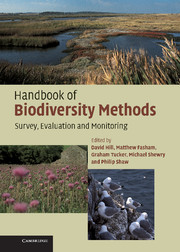Book contents
- Frontmatter
- Contents
- Preface
- Acknowledgements
- Part I Planning
- Part II Habitats
- Part III Species
- 9 Introduction to species assessment
- 10 General principles and methods for species
- 11 Fungi
- 12 Lichens
- 13 Bryophytes
- 14 Aquatic macrophytes and algae
- 15 Vascular plants
- 16 Dragonflies and damselflies
- 17 Butterflies
- 18 Moths
- 19 Other terrestrial invertebrates
- 20 Aquatic invertebrates
- 21 Fish
- 22 Amphibians
- 23 Reptiles
- 24 Birds
- 25 Bats
- 26 Other mammals
- Appendix 1 Monitoring and reporting obligations under international conservation agreements
- Appendix 2 Relationship between BAP Priority Habitat and Broad Habitat categories and Habitats Directive nomenclature
- Appendix 3 Annotated list of key references for plant identification
- Appendix 4 Determining appropriate quadrat size for vegetation sampling
- Appendix 5 The relocation of permanent plots
- Appendix 6 Equipment required for undertaking different types of survey
- Recommended sources of further information
- References
- Glossary
- Index
16 - Dragonflies and damselflies
Published online by Cambridge University Press: 01 September 2010
- Frontmatter
- Contents
- Preface
- Acknowledgements
- Part I Planning
- Part II Habitats
- Part III Species
- 9 Introduction to species assessment
- 10 General principles and methods for species
- 11 Fungi
- 12 Lichens
- 13 Bryophytes
- 14 Aquatic macrophytes and algae
- 15 Vascular plants
- 16 Dragonflies and damselflies
- 17 Butterflies
- 18 Moths
- 19 Other terrestrial invertebrates
- 20 Aquatic invertebrates
- 21 Fish
- 22 Amphibians
- 23 Reptiles
- 24 Birds
- 25 Bats
- 26 Other mammals
- Appendix 1 Monitoring and reporting obligations under international conservation agreements
- Appendix 2 Relationship between BAP Priority Habitat and Broad Habitat categories and Habitats Directive nomenclature
- Appendix 3 Annotated list of key references for plant identification
- Appendix 4 Determining appropriate quadrat size for vegetation sampling
- Appendix 5 The relocation of permanent plots
- Appendix 6 Equipment required for undertaking different types of survey
- Recommended sources of further information
- References
- Glossary
- Index
Summary
Dragonflies and damselflies (Odonata) have an aquatic larval stage, which can last for a few years, followed by emergence, mating and dying all in the same season. As larvae can live for long periods before pupating, an absence (or decrease) of adults in one year does not necessarily imply that the population is in decline. Several years of negative results are required to confirm an absence.
Surveys of Odonata can provide a useful indicator of water and habitat quality where regional differences in diversity are taken into account. This is one reason why they are a useful group to survey as part of EIA studies.
Monitoring areas of suitable habitat may be appropriate, particularly if resources are not available for more detailed survey methods. Monitoring of micro-habitats is not specifically covered in this Handbook. However, some of the techniques in Part II may be adapted for this purpose.
ATTRIBUTES FOR ASSESSING CONDITION
Population range
Area of occupancy is an important attribute to monitor and can be best assessed by mapping presence – absence in suitable micro-habitats. Note that presence in the only pond in a 100 ha site gives 100% occupancy, even though most of the site lacks the species. At the same time, a presence in 50 ponds in the same area is only 50% occupancy if there are 100 ponds. Area of occupancy must therefore be defined in terms of the area of suitable micro-habitat occupied. Repeat surveys will illustrate expansions or contractions of range.
- Type
- Chapter
- Information
- Handbook of Biodiversity MethodsSurvey, Evaluation and Monitoring, pp. 322 - 327Publisher: Cambridge University PressPrint publication year: 2005

